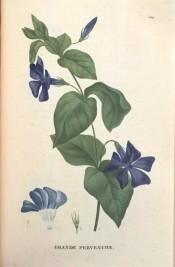Vinca major L.
Fully-hardy, prostrate, evergreen shrub with arching shoots and long, non-rooting trailing stems, lance-shaped leaves, to 9cm long, and blue-violet, salverform flowers, to 5cm across, from spring to autumn. To 45cm. [RHSE, Hilliers’, Hortus].
Horticultural & Botanical History
A popular cottage garden plant, long naturalised in the southern half of Britain. Described by John Parkinson in Paradisi in Sole Paradisus Terrestris (1629) as the Greater Perwinkle. Parkinson distinguishes it from the Lesser Periwinkle: ‘This Greater Perwinkle is somewhat like the former [double form of Vinca minor] , but greater, yet his branches creepe not in that manner, but stand more upright, or lesse creeping at the least: the leaves also hereof stand couples at the joints, but they are broader and larger by the halfe: the flowers are larger, consisting of five leaves that are blew, a little deeper than the former blew: this plant is farre tenderer to keep than the other, and therefore would stand warme, a well as in a moist shadowy place.’ Saint-Hilaire Tr. pl.124/1825.
History at Camden Park
Listed only in the 1850 and 1857 catalogues [T.998/1850]. Possibly obtained Macarthur from J. Abbott of Hobart from whom it was requested on 16th June 1846. [MP A2933-2, p.159].
Notes
Vinca major Brot. = Vinca difformis Pourr., from the western Mediterranean, similar to Vinca major L. but less hardy. [RHSD].
Published Jun 03, 2009 - 03:15 PM | Last updated Jul 14, 2010 - 12:27 PM
| Family | Apocynaceae |
|---|---|
| Category | |
| Region of origin | Western Mediterranean |
| Synonyms | |
| Common Name | Greater periwinkle, Large periwinkle |
| Name in the Camden Park Record | Vinca major |
| Confidence level | high |
